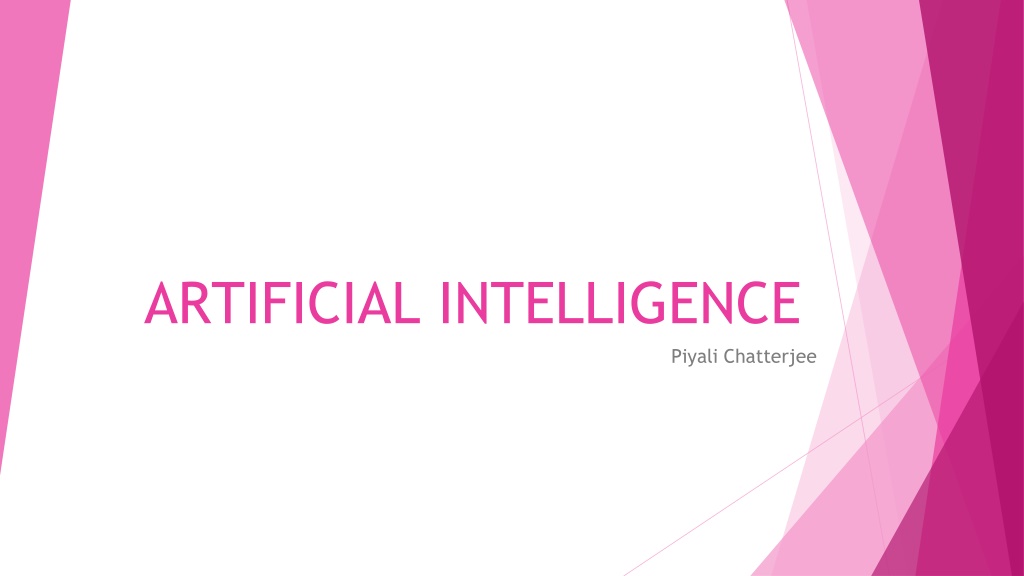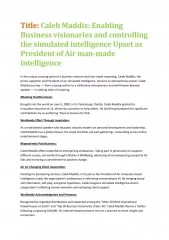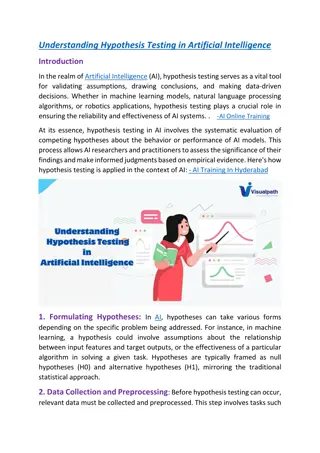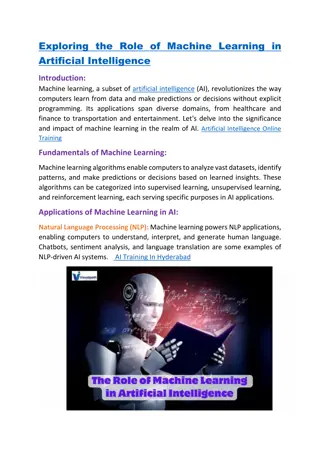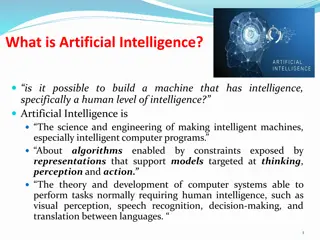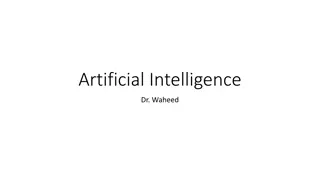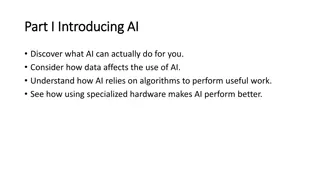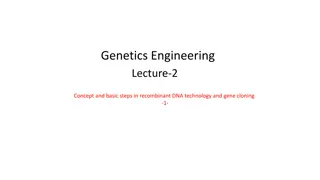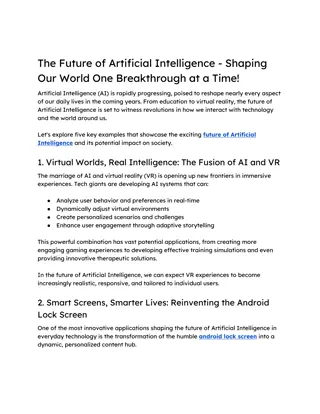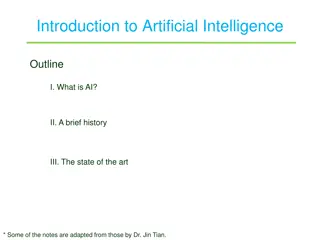Understanding Different Types of Artificial Intelligence
Artificial Intelligence is categorized into Narrow AI (Weak AI), General AI, and Super AI based on capabilities, while Reactive Machines, Limited Memory, Theory of Mind, and Self-Awareness are types based on functionality. Each type serves a specific purpose with varying levels of intelligence. Narrow AI is task-specific, General AI aims to think like a human, Super AI surpasses human intelligence, Reactive Machines operate based on current scenarios, Limited Memory machines store past data, Theory of Mind AI focuses on understanding human emotions, and Self-Awareness AI is envisioned as highly intelligent and self-aware. The evolution of AI continues to shape the future of technology.
Download Presentation

Please find below an Image/Link to download the presentation.
The content on the website is provided AS IS for your information and personal use only. It may not be sold, licensed, or shared on other websites without obtaining consent from the author. Download presentation by click this link. If you encounter any issues during the download, it is possible that the publisher has removed the file from their server.
E N D
Presentation Transcript
ARTIFICIAL INTELLIGENCE Piyali Chatterjee
AI type-1: Based on Capabilities Weak AI or Narrow AI: Narrow AI is a type of AI which is able to perform a dedicated task with intelligence. The most common and currently available AI is Narrow AI in the world of Artificial Intelligence. Narrow AI cannot perform beyond its field or limitations, as it is only trained for one specific task. Hence it is also termed as weak AI. Narrow AI can fail in unpredictable ways if it goes beyond its limits. Apple Siriis a good example of Narrow AI, but it operates with a limited pre- defined range of functions. Narrow AI are playing chess, purchasing suggestions on e-commerce site, self- driving cars, speech recognition, and image recognition.
General AI: General AI is a type of intelligence which could perform any intellectual task with efficiency like a human. The idea behind the general AI to make such a system which could be smarter and think like a human by its own. Currently, there is no such system exist which could come under general AI and can perform any task as perfect as a human.
Super AI Super AI is a level of Intelligence of Systems at which machines could surpass human intelligence, and can perform any task better than human with cognitive properties. It is an outcome of general AI. Some key characteristics of strong AI include the ability to think, to reason,solve the puzzle, make judgments, plan, learn, and communicate by its own. Super AI is still a hypothetical concept of Artificial Intelligence. Development of such systems in real is still world changing task.
AI type-2: Based on functionality Reactive Machines Purely reactive machines are the most basic types of Artificial Intelligence. Such AI systems do not store memories or past experiences for future actions. These machines only focus on current scenarios and react on it as per possible best action. Example: IBM's Deep Blue system is an example of reactive machines. Limited Memory Limited memory machines can store past experiences or some data for a short period of time. These machines can use stored data for a limited time period only. Self- driving cars are one of the best examples of Limited Memory systems. These cars can store recent speed of nearby cars, the distance of other cars, speed limit, and other information to navigate the road.
AI type-2: Based on functionality..contd Theory of Mind Theory of Mind AI should understand the human emotions, people, beliefs, and be able to interact socially like humans. This type of AI machines are still not developed, but researchers are making lots of efforts and improvement for developing such AI machines. 4. Self-Awareness Self-awareness AI is the future of Artificial Intelligence. These machines will be super intelligent, and will have their own consciousness, sentiments, and self- awareness. These machines will be smarter than human mind. Self-Awareness AI does not exist in reality still and it is a hypothetical concept.
Intelligent Agent Agent is anything that can be viewed as perceiving its environment through sensors and acting upon that environment through actuators. A human agent has eyes, ears and other organs for sensors, hands, legs mouth for actuators. A robotic agent might have cameras and infrared range finders for sensors and various motors for actuators. A software agent receives keystrokes , file contents, and network packets as sensory inputs and acts on the environment by displaying on the screen , writing files and sending network packets.
Intelligent Agentcontd The job of AI is to design the agent program: a function that implements the agent mapping from percepts to actions. We assume this program will run on some sort of computing device, which we will call the architecture. Obviously, the program we choose has to be one that the architecture will accept and run. The architecture might be a plain computer, or it might include special-purpose hardware for certain tasks, such as processing camera images or filtering audio input. The relationship among agents, architectures, and programs can be summed up as follows: agent = architecture + program
PEAS Representation PEAS is a type of model on which an AI agent works upon. When we define an AI agent or rational agent, then we can group its properties under PEAS representation model. It is made up of four words: P: Performance measure E: Environment A: Actuators S: Sensors Here performance measure is the objective for the success of an agent's behavior.
PEAS of Self driving Car Let's suppose a self-driving car then PEAS representation will be: Performance: Safety, time, legal drive, comfort Environment: Roads, other vehicles, road signs, pedestrian Actuators: Steering, accelerator, brake, signal, horn Sensors: Camera, GPS, speedometer, odometer, accelerometer, sonar.
PEAS of Medical Diagnose Performance: Healthy patient, Minimized cost Environment: patient, Hospital, Staff Actuators: Tests, Treatments Sensors: Keyboard (Entry of symptoms)
PEAS of Vacuum Cleaner Performance: Cleanliness, Efficiency, Battery life, Security Environment: Room, Table, Wood floor, Carpet, Various obstacles Actuators: Wheels, Brushes, Vacuum Extractor Sensors: Camera, Dirt detection sensor, Cliff sensor, Bump Sensor, Infrared Wall Sensor
Types of AI Agents Agents can be grouped into five classes based on their degree of perceived intelligence and capability. All these agents can improve their performance and generate better action over the time. These are given below: Simple Reflex Agent Model-based reflex agent Goal-based agents Utility-based agent Learning agent
Simple Reflex agent: The Simple reflex agents are the simplest agents. These agents take decisions on the basis of the current percepts and ignore the rest of the percept history. These agents only succeed in the fully observable environment. The Simple reflex agent does not consider any part of percepts history during their decision and action process. The Simple reflex agent works on Condition-action rule, which means it maps the current state to action. Such as a Room Cleaner agent, it works only if there is dirt in the room. Problems for the simple reflex agent design approach: They have very limited intelligence They do not have knowledge of non-perceptual parts of the current state Mostly too big to generate and to store. Not adaptive to changes in the environment.
Model-based reflex agent The observable environment, and track the situation. Model-based agent can work in a partially A model-based agent has two important factors: Model: It is knowledge about "how things happen in the world," so it is called a Model-based agent. Internal State: It is a representation of the current state based on percept history. These agents have the model, "which is knowledge of the world" and based on the model they perform actions. Updating the agent state requires information about: How the world evolves How the agent's action affects the world.
Goal-based agents The knowledge of the current state environment is not always sufficient to decide for an agent to what to do. The agent needs to know its goal which describes desirable situations. Goal-based agents expand the capabilities of the model- based agent by having the "goal" information. They choose an action, so that they can achieve the goal. These agents may have to consider a long sequence of possible actions before deciding whether the goal is achieved or not. Such considerations of different scenario are called searching and planning, which makes an agent proactive.
Utility-based agents These agents are similar to the goal-based agent but provide an extra component of utility measurement which makes them different by providing a measure of success at a given state. Utility-based agent act based not only goals but also the best way to achieve the goal. The Utility-based agent is useful when there are multiple possible alternatives, and an agent has to choose in order to perform the best action. The utility function maps each state to a real number to check how efficiently each action achieves the goals.
Learning Agents A learning agent in AI is the type of agent which can learn from its past experiences, or it has learning capabilities. It starts to act with basic knowledge and then able to act and adapt automatically through learning. A learning agent has mainly four conceptual components, which are: Learning element: It is responsible for making improvements by learning from environment Critic: Learning element takes feedback from critic which describes that how well the agent is doing with respect to a fixed performance standard. Performance element: It is responsible for selecting external action Problem generator: This component is responsible for suggesting actions that will lead to new and informative experiences. Hence, learning agents are able to learn, analyze performance, and look for new ways to improve the performance.
Agent Environment in AI An environment is everything in the world which surrounds the agent, but it is not a part of an agent itself. An environment can be described as a situation in which an agent is present. The environment is where agent lives, operate and provide the agent with something to sense and act upon it.
Features of Environment As per Russell and Norvig, an environment can have various features from the point of view of an agent: 1. Fully observable vs Partially Observable 2. Static vs Dynamic 3. Discrete vs Continuous 4. Deterministic vs Stochastic 5. Single-agent vs Multi-agent 6. Episodic vs sequential
Fully observable vs Partially Observable: If an agent sensor can sense or access the complete state of an environment at each point of time then it is a fully observable environment, else it is partially observable. A fully observable environment is easy as there is no need to maintain the internal state to keep track history of the world. Example (fully observable ): In a chess game, the state of the system, that is, the position of all the players on the chess board, is available the whole time so the player can make an optimal decision. Example (partially observable ): Playing card games is a perfect example of a partially-observable environment where a player is not aware of the card in the opponent's hand. An agent with no sensors in all environments then such an environment is called as unobservable.
Deterministic vs Stochastic: If an agent's current state and selected action can completely determine the next state of the environment, deterministic environment. then such environment is called a A stochastic environment is random in nature and cannot be determined completely by an agent. In a deterministic, fully observable environment, agent does not need to worry about uncertainty. Examples: Taxi driving : Stochastic Vaccum cleaner world: deterministic
Episodic vs Sequential: In an episodic environment, there is a series of one-shot actions, and only the current percept is required for the action. However, in Sequential environment, an agent requires memory of past actions to determine the next best actions. Examples: An agent that has to spot defective parts on an assembly line bases each decision on the current part, regardless of previous decisions; moreover the current decision doesn t affect whether the next part is defective. Chess and taxi driving are sequential.
Single-agent vs Multi-agent If only one agent is involved in an environment, and operating by itself then such an environment is called single agent environment. However, if multiple agents are operating in an environment, then such an environment is called a multi-agent environment. The agent design problems in the multi-agent environment are different from single agent environment. Examples: Agent solving a crossword puzzle by itself is clearly in a single- agent environment whereas an agent playing chess is in a two-agent environment.
Static vs Dynamic: If the environment can change itself while an agent is deliberating then such environment is called a dynamic environment else it is called a static environment. Static environments are easy to deal because an agent does not need to continue looking at the world while deciding for an action. However for dynamic environment, agents need to keep looking at the world at each action. Taxi driving is an example of a dynamic environment whereas Crossword puzzles are an example of a static environment.
Discrete vs Continuous: If in an environment there are a finite number of percepts and actions that can be performed within it, then such an environment is called a discrete environment else it is called continuous environment. A chess game comes under discrete environment as there is a finite number of moves that can be performed. A self-driving car is an example of a continuous environment.
